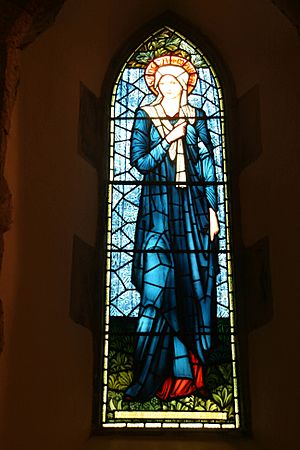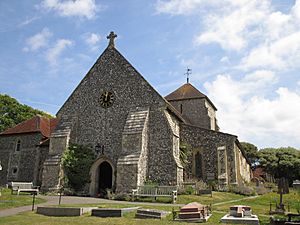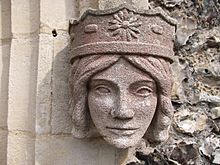St Margaret's Church, Rottingdean facts for kids
Quick facts for kids St Margaret, Rottingdean |
|
|---|---|

The church from the southwest
|
|
| 50°48′24″N 0°03′27″W / 50.8068°N 0.0575°W | |
| Denomination | Church of England |
| Website | www.stmargaret.org.uk |
| History | |
| Dedication | Margaret of Antioch |
| Administration | |
| Parish | Rottingdean, St Margaret |
| Deanery | Rural Deanery of Brighton |
| Archdeaconry | Chichester |
| Diocese | Chichester |
| Province | Canterbury |
St Margaret's Church is an Anglican church located in the village of Rottingdean. Rottingdean is part of the city of Brighton and Hove, England. This church is the main church for the Rottingdean area. Some parts of the building are very old, dating back to the 13th century. It is considered a very important historical building and is listed as a Grade II* listed building.
Contents
History of St Margaret's Church
The church stands in the northeast corner of the Green, which is the oldest part of Rottingdean. People have worshipped in this spot since the Saxon period. However, experts are not sure if any parts of the current church are from Saxon times.
Building the Church: Early Years
The Normans started building a church shaped like a cross (a cruciform church) in the early 12th century. But the tower, which was where the Saxon building's chancel (the area around the altar) used to be, fell down during construction. This destroyed the new chancel and the transept (the parts that stick out like arms of the cross). Luckily, the nave (the main part of the church where people sit) survived.
By the early 13th century, the chancel was rebuilt. The nave was also made longer by adding four bays (sections of the building). These were added to the south side of the church. However, this part stopped being used after 1377. This was because French invaders attacked the coast nearby and sacked (attacked and robbed) the church and other buildings. The west wall of the church was also damaged and had to be rebuilt. The south side was then blocked off.
Changes in the 19th and 20th Centuries
The church stayed mostly the same until a big repair project in 1856. This was led by Sir George Gilbert Scott, a famous architect. A new south aisle with three bays was built. Scott even moved an old window from the original aisle and put it into one of the new walls. The chancel wall was also partly rebuilt.
Earlier in the 19th century, box pews (enclosed seats) and a gallery (a raised seating area) were added. Scott removed the gallery during his restoration work.

In the 20th century, more additions were made. A porch was built at the west entrance in 1908. Vestries (rooms for clergy and church items) were added in the 1970s. These new parts were designed to match the old style of the church. A new gallery was also built in 1908 at the west end of the nave. This gallery holds the organ. The original gallery had been on the south side.
An interesting discovery happened when the bowl of the original Norman font (a basin for baptisms) was found in the vicarage garden. A copy was made in 1910, and the original bowl was put on display inside the church.
Famous Connections
Many famous people have connections to St Margaret's Church. Lucy Ridsdale, whose father lived in Rottingdean, married Stanley Baldwin in the church in 1892. Stanley Baldwin later became the Prime Minister of the United Kingdom three times. The Baldwins gave a special chair to the church in 1942, which is still in the chancel.
Sir Edward Burne-Jones, a famous artist, designed many of the beautiful stained-glass windows in the church. He lived in a house on the village green for 18 years until he passed away in 1898. He was also the uncle of the famous author and poet Rudyard Kipling. Kipling moved to a nearby house called The Elms in 1897. He wrote many of his famous Just So Stories while living there.
A Church for Sale?
In the early 1900s, something very unusual happened. Developers from the Forest Lawn Memorial Park, a private cemetery in California, wanted to buy St Margaret's Church! They planned to take it apart stone by stone, ship it to the United States, and rebuild it there. They offered a price, but the church refused to sell.
So, in the 1940s, the developers had drawings made of the church. They then built an exact copy of it in California. This replica church was named the Church of the Recessional. It was named after Kipling's poem "Recessional".
Architecture of St Margaret's
The church is built mainly from flint (a type of stone), with other stone details and a tiled roof. The flint used in the 19th-century repairs by Scott is laid out more evenly than the older, more random flint walls.
The main entrance is at the west end, facing the village green. You reach it through a lychgate (a covered gateway to a churchyard) built in 1897. This lychgate remembers Revd Arthur Thomas, who was the vicar for 47 years. Two windows in the square tower also remember him. The entrance door has two strong buttresses (supports) on either side. On top of the steep roof at the west end is a small cross, and a large clock is set into the wall below it.
The main parts of the church – the nave, chancel, and tower – are all original. There are many trefoil (three-lobed) and lancet windows (tall, narrow windows) on all sides. Many of these windows have stained glass, and most were designed by Edward Burne-Jones. The east wall, for example, has three tall lancet windows and a quatrefoil (a four-lobed shape). These lancet windows were put in in 1893 to celebrate Burne-Jones's daughter Margaret's marriage. They show the archangels Gabriel, Michael, and Raphael.
St Margaret's Church Today
St Margaret's was officially listed as a Grade II* building on October 13, 1952. This means it is a particularly important building of more than special interest. As of February 2001, it was one of 70 Grade II*-listed buildings in Brighton and Hove.
The church is still actively used for worship today. It is the only Anglican church in the Benefice (a group of parishes) of Rottingdean. The church's parish covers all of Rottingdean, reaching to the edges of Ovingdean and Saltdean. It also includes the coast road up to Roedean and the surrounding downland areas.
Burials and Memorials
The ashes of Sir Edward Burne-Jones, the famous Pre-Raphaelite artist, are buried in the churchyard. His wife Georgiana and their granddaughter, the novelist Angela Thirkell, are also buried there.
The old churchyard was made larger in 1883, 1905, and 1920. The churchyard also holds the graves of other notable people. These include Scottish novelist William Black, G. H. Elliott the Music Hall singer, and the world-famous blues guitarist Gary Moore (who passed away in 2011).
In 2020, the words on the gravestones of music hall singers G. H. Elliott and Alice Bamford were changed. This was because some of the old terms used on their gravestones had become offensive over time.
The churchyard also contains 14 Commonwealth war graves. These are for nine British service members from World War I (including one unidentified sailor) and four from World War II.
See also
- Grade II* listed buildings in Brighton and Hove
- List of places of worship in Brighton and Hove




